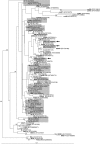Unapparent microsporidial infection among immunocompetent humans in the Czech Republic
- PMID: 21191056
- PMCID: PMC3067711
- DOI: 10.1128/JCM.01147-10
Unapparent microsporidial infection among immunocompetent humans in the Czech Republic
Abstract
In the present population-based study, we determined the prevalences of the most common human-pathogenic microsporidia, Encephalitozoon spp. and Enterocytozoon bieneusi, in asymptomatic healthy people living in the Czech Republic. A total of 382 males and females (ages, 1 to 84 years) living in the Czech Republic, of whom 265 were Czech nationals and 117 were foreign students, were included in a study testing for the presence of microsporidia by use of coprology and molecular methods. Single-species infections with Enterocytozoon bieneusi or an Encephalitozoon sp. were detected for 9 and 136 individuals, respectively. Moreover, coinfections were detected for 14 individuals. Four genotypes of 3 human-pathogenic Encephalitozoon spp. and 7 E. bieneusi genotypes, including 3 novel genotypes, were detected. Some of these were reported in humans for the first time. The highest prevalence was recorded for individuals older than 50 years and for loose, unformed stool samples. These findings clearly show that exposure to microsporidia is common among immunocompetent people and that microsporidiosis is not linked to any clinical manifestation in healthy populations.
Figures

References
-
- Abreu-Acosta N., et al. 2005. Enterocytozoon bieneusi (microsporidia) in clinical samples from immunocompetent individuals in Tenerife, Canary Islands, Spain. Trans. R. Soc. Trop. Med. Hyg. 99:848–855 - PubMed
-
- Cotte L., et al. 1999. Waterborne outbreak of intestinal microsporidiosis in persons with and without human immunodeficiency virus infection. J. Infect. Dis. 180:2003–2008 - PubMed
-
- Cotte L., et al. 1993. Prevalence of intestinal protozoans in French patients infected with HIV. J. Acquir. Immune Defic. Syndr. 6:1024–1029 - PubMed
-
- Coyle C. M., et al. 1996. Prevalence of microsporidiosis due to Enterocytozoon bieneusi and Encephalitozoon (Septata) intestinalis among patients with AIDS-related diarrhea: determination by polymerase chain reaction to the microsporidian small-subunit rRNA gene. Clin. Infect. Dis. 23:1002–1006 - PubMed
-
- Croppo G. P., Gomez Morales M. A., Pozio E. 1991. Microsporidia infections in immunocompetent and immunosuppressed subjects. Parassitologia 33:209–218 (In Italian.) - PubMed
Publication types
MeSH terms
Substances
Associated data
- Actions
- Actions
- Actions
LinkOut - more resources
Full Text Sources
Miscellaneous

